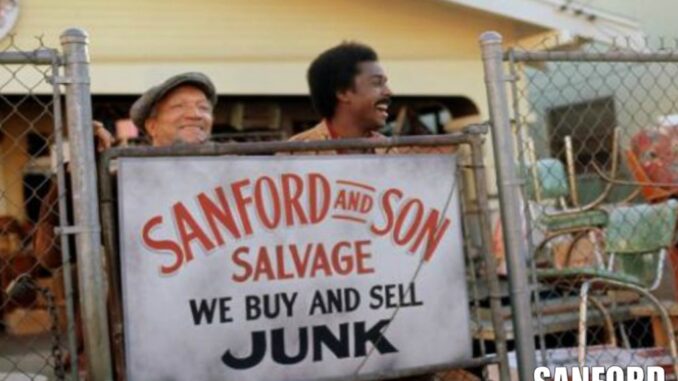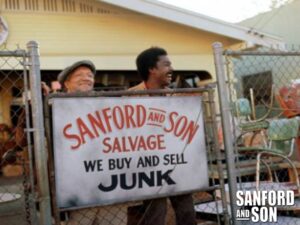
The Site of Sanford and Son Salvage from “Sanford and Son” (continue)

In “Alley Cat,” the Squad 51 paramedics are called to a scrapyard to help a junk dealer who has gotten his foot stuck in a bear trap. Shady Grady explains that as the firefighters head to the scene “they pass an intersection, and a streetlight next to a power pole, then a vacant lot, then the store.” As the street sign visible in the background of the segment (denoted with blue arrows below) shows us, the intersection the rescuers drive through is that of Magnolia and Cahuenga. Amazingly, the 7-Eleven they pass (marked with pink arrows) is still there today, though its signage no longer looks as it did at the time of the filming.
When the paramedics exit their vehicle, a portion of the junkyard’s green, yellow and white awning is visible. That awning should be familiar to Sanford and Son fans. As Shady Grady notes, it is a perfect match to the S&S Salvage awning – even down to the bent grim trim!
Shady Grady goes on to say, “Pay attention to the buildings in the background and then go to the address above [10659 West Magnolia Boulevard] in Google Earth. As you look around in street view, you’ll see the stores across the street are still the same.” Though the corner building (denoted with pink arrows below) at 10626 West Magnolia looks a bit different today, it still bears the rounded shape it did on Emergency! The billboard seen in the episode (blue arrows), as well as the scaffold holding it (purple arrows) and the vacant area where it is situated are all direct matches to what appeared on “Alley Cat.” The overhang and door and window configuration of the building just east of the billboard (green arrows) at 10644 West Magnolia also remain frozen in time to when Emergency! was filmed.
When “Alley Cat” was shot, the junkyard was located next to an empty lot. That is now where the Actors Forum Theatre (10655 West Magnolia) stands. Adjacent to that was a thin one-story building (denoted with pink arrows below). That site now houses a Poquito Más outpost (10651 West Magnolia) and still looks much the same as it did onscreen in 1973. Across the street from that structure was some sort of auto supply store (blue arrows). Little of that spot has changed in the ensuing years. In fact, it is still home to an automotive store – San Fernando Tires & Wheels (10637 West Magnolia).
Shady Grady finishes up by saying, “Compare that to the opening credits of Sanford and Son and it falls into place. As Lamont pulls in the driveway, you can see a sign in front of the house, to the right of the driveway [pink arrow] and a power pole to the left of the driveway [blue arrow]. Both are in the Google earth photo.” The building with the angled overhang [purple arrow] seen in the background of the opening credits also remains the same today.
Being that the locale portrayed a junkyard in two different productions, I figured it was likely one in real life, too – at least at the time each was lensed. User waterguybob had written in to the message board in September 2014 to say that he had grown up three blocks away from 10659 West Magnolia and that it was indeed the site of Sanford and Son Salvage (he had even witnessed the filming!). While he said that the property housed a junkyard known as “Joe’s Junk Shop” during the shoot, I could not find any mentions of that name online or any definitive proof of his assertion – until I registered with newspapers.com, that is. Thanks to the incredible (albeit pricey!) stalking tool, I was able to uncover quite a bit of the locale’s history. Via the advertisement pictured below, which ran in the September 21st, 1967 issue of The Los Angeles Times, we know that 10659 Magnolia was the site of an actual junkyard at least as far back as that date, though it appears to have had no name at the time.

I hit pay dirt thanks to the October 8th, 1977 Valley News article below, which detailed the locale’s transition from a junkyard named “The Select Shoppe” into a theatre. Yep, you read that right. According to author Bobbi Zane, somewhere around late 1975, proprietor Joe Lawler turned his long-running scrapyard into a live performance venue known as the Junk Yard Theater. As Zane states, “He’d been donating props occasionally for various productions and his shop was well known to many actors. One day an actor strode into the shop and suggested, ‘Why don’t you make a theatre out of the junk yard?’ The idea struck home, and in short order Lawler had cleared the yard and had his first production underway. It was ‘Everybody Loves Opa [sic],’ appropriately concerning a man who runs a junk store.” Though the place still had the feel of a wrecking yard, with Zane stating “old furniture, bicycle parts, kitchen utensils, tools line the path every patron has to make his way through to get to the theater,” Lawler did add Astroturf, two fish ponds, and plenty of foliage, transforming the site into a “lovely” space.
I am unsure of what year the Junk Yard Theater shuttered, but per various newspapers ads and blurbs plays were running on the premises through October 1978.
I could not find any articles detailing the razing or remodeling of the site, so I next headed over to the Los Angeles Department of Building and Safety website to search building records and quickly discovered that the Sanford and Son Salvage storefront, along with the property next to it at 10661 West Magnolia, were demolished in March 1989. New structures were subsequently built in their place that same year. So while some have surmised that the locale might have merely been altered in the years since filming took place, I can safely – and sadly – say that is not the case. Sanford and Son Salvage no longer exists.
During my research, I came across the Sanford and Son publicity shot pictured below. (You can see similar images here, here, here, and here.) Interestingly, though a sign reading “Sanford and Son Salvage” is positioned on the fence, the photo was obviously not lensed at the Magnolia Boulevard location, being that no house was ever situated there. I am unsure of where exactly the picture was taken or why a different locale was used for it, but if anyone happens to know, please fill me in.
